Raise High Your Razors, Wool Wearers!
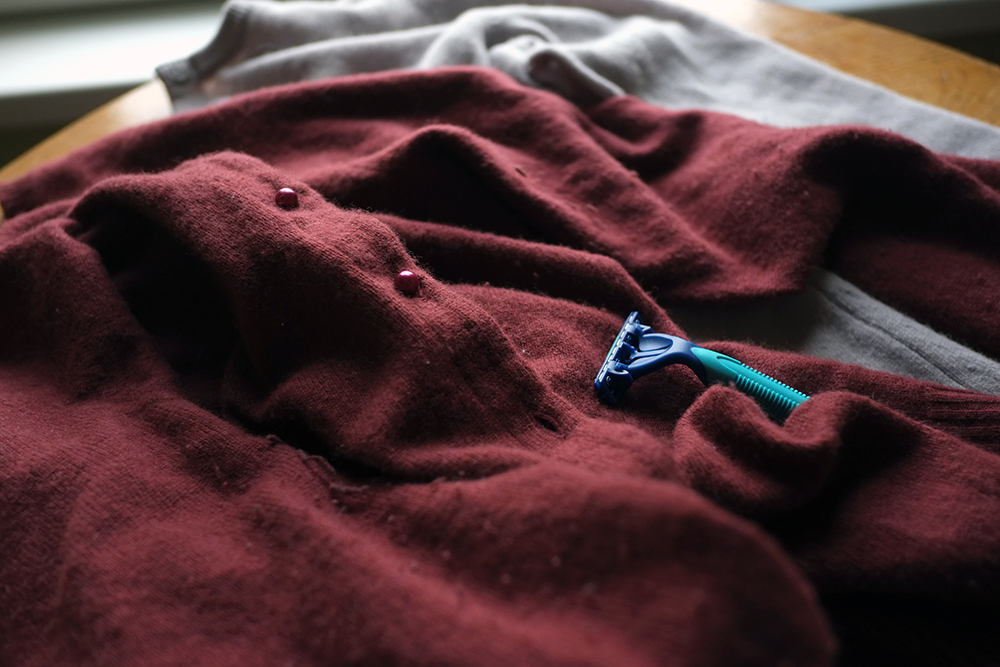
As I make no secret of being a wool enthusiast, perhaps it is not surprising that most of the questions I get from readers that aren't about bicycles, are about wool. Some are just trying to get their heads around the idea that this traditional, low-tech fabric can be worn on the bike in leu of modern synthetics, and often with better results. Others have specific questions about care and maintenance. Being a natural fabric, wool has a reputation for being delicate - vulnerable to the ravages of moths, washing machines (I offer a solution to the latter here), even everyday wear. Consider, for instance, this reader's lament:
...Following the advice of blogs such as yours and Let's Go Ride A Bike, I stocked up on merino sweaters since I began bicycle commuting. I have also bought a couple of wool cycling jerseys. The wool feels fantastic to wear, I was in love. Unfortunately, after only one season I find that most of my wool tops are ruined with pilling and felting, fit for nothing but yard work! So... what am I doing wrong? Is this a question of quality and if so what brands should I be looking at? Please help me get more life out of my woolens!Well, actually I am happy to tell you, there is a very simple solution to this. So if you notice your wool garment pilling (forming tiny balls of fluff that make it look old and worn before its time) or felting (the stitches losing their structure and instead fuzzing over with a dense, weblike layer), don't throw it out or relegate it to yardwork apparel just yet. Instead, get out your razor and read on.
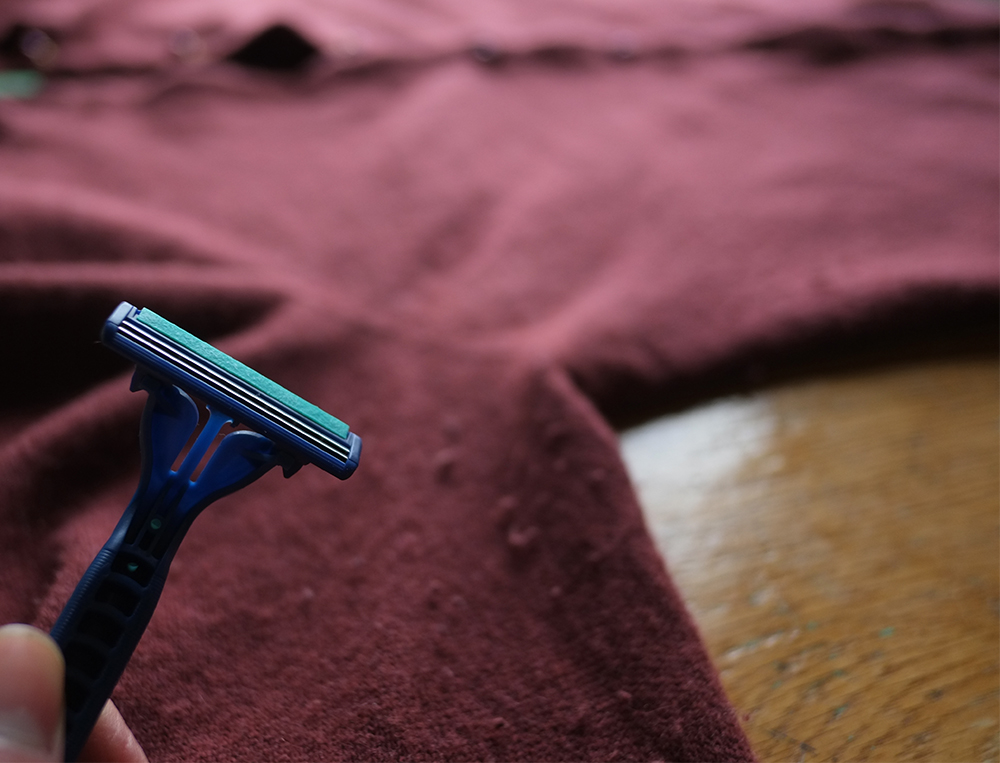
Firstly, there is nothing necessarily wrong with the quality of the wool you are buying. Rather, the pilling and felting are a result of manufacturers using ever-softer wool to deliver the silky, luxurious feel most customers want. The softer, fluffier the wool, the more susceptible the fibres are to shedding fluff, which then, through friction of movement, gets bunched up and rolled into the unsightly "outgrowths" you see. But not to worry, as these can easily be removed by simply "shaving" them off when you notice them forming. It's a simple method that most knitters are familiar with as the final step to making their work look presentable. And you can use it quite safely on anything from cashmere sweaters to cycling jerseys.
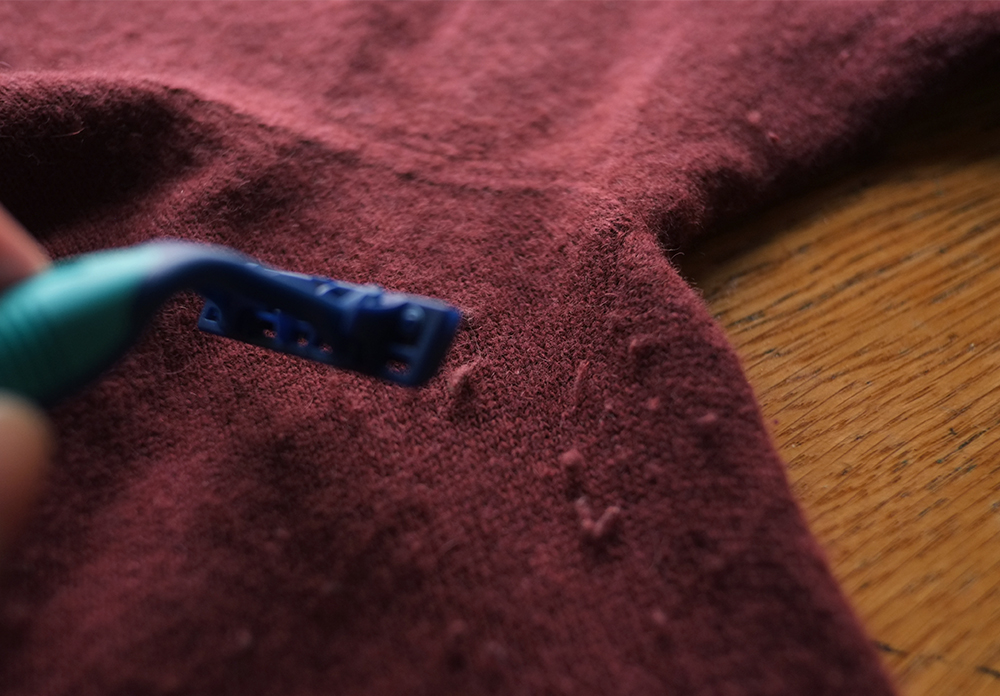
Begin by laying your garment out flat on a hard surface. Use a sharp, brand new razor. Focusing on one area at a time, move the blade lightly and evenly over the fabric without digging into it. This way, you shave off the fuzzballs/ web of felting, but don't touch the stitches underneath.
If this sounds like a delicate operation, it's not really. It is surprisingly difficult to cut into the actual stitches. As long as you have the fabric laid out flat and are moving the blade in parallel to it, you should be able to shave to your heart's content until all the fuzz is removed, without worrying about damage.
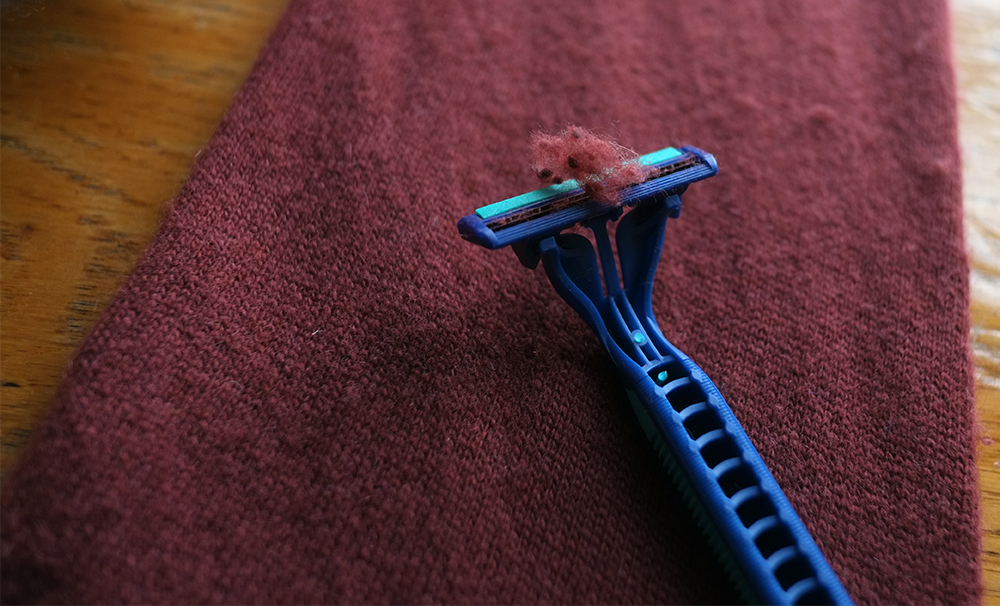
When you've finished with an area, remove the fluff that will have built up in your razor blades and move on to the next patch - until you are left with a smooth expanse of crisp woolen stitches.
In the end, your clothes will look as fresh and presentable as it did when brand-new!
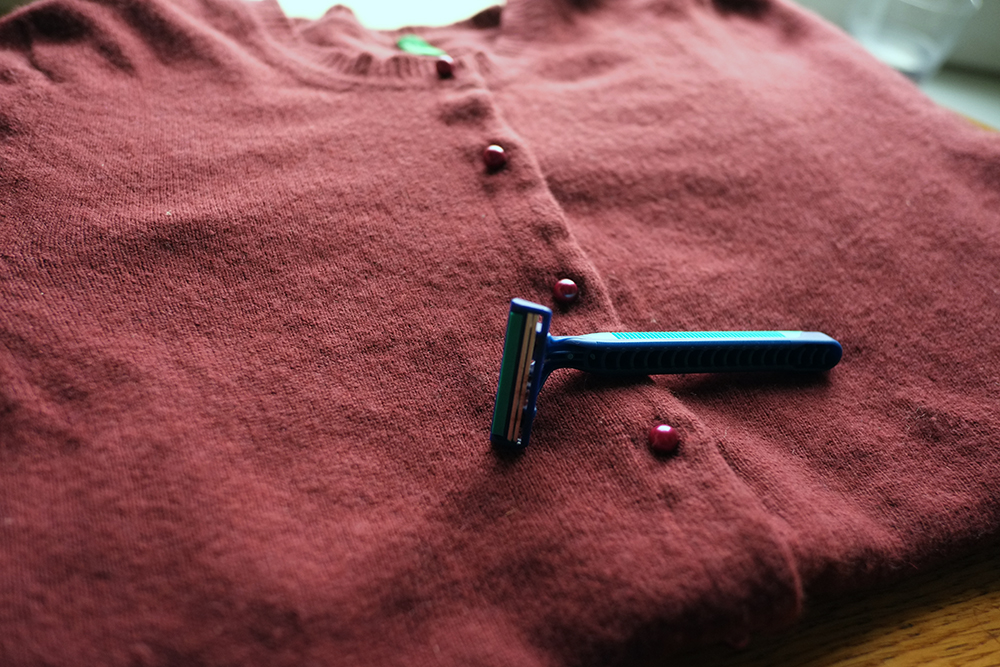
How many times can you do this before the garment becomes threadbare? Honestly, I would not worry about that. The cardigan you see in the photos I have owned for 8 years, and it has withstood many a shaving. So wield your razors with impunity, and stay cozy in wool on your bike this winter - judging by the snow we're already getting in November, this will be a wool-heavy season indeed!

After many years working in a yarn store and caring for handknit (and commercial) wool goods, I really have to say that, despite the name, The Gleener (http://gleener.com/category/products/ultimate-fuzz-remover/) is really excellent. Nothing wrong with a razor or a sweater stone, but I like the option of different 'edges' for different types of fabric - makes a world of difference.
ReplyDeleteThank you - reading your comment, I realised that I have accidentally removed a paragraph that mentioned this specialised equipment! Someone gave me the "gleener" as a gift years ago. It worked, but the problem is that I move around and travel a lot, so can't be trusted to keep track of little thingamajigs like that, not to mention the multiple attachments! It wasn't long before I lost it. The reason I recommend razors is only because they are so cheap and easily available.
DeleteSeeing as wool clothing, especially the Merino variety, costs roundabout 900 dollars or so, I'm going to hold on to every fiber of it I can. When the day comes where I'm shearing my own sheep, perhaps I'll shave my sweaters then.
ReplyDeleteIf you are not averse to vintage/thrift shopping, you can follow LGRAB's lead and buy your wool in 2nd hand shops. I believe Dottie has an entire collection of $5-10 cashmere sweaters. And for men, 2nd hand wool sweaters are especially plentiful.
DeleteThat's a good idea, I'm never really looking for cashmere because of the high costs associated with it, but I suppose its just as likely to be in a thrift store. At first, I thought almost everything in Germany was wool, but soon realized that "Baumwolle" was neither wool nor made from trees.
DeleteWhen I asked a German friend why "tree wool" means cotton, she pointed out that hot dogs are neither hot nor made of dogs. Two surprises in one day.
Delete
ReplyDeleteI've bought a few nice second hand/vintage jerseys and really appreciate getting nice wool for a fraction of what it cost new, about half of them seem to have been passed on simply because of "pilling". I've never used a razor but what I did do was sit down for half an hour and pick them off Chimpanzee style(I didn't eat them though). If you PINKY PROMISE I'm not going to damage them I'll be happy to try the razor but if I slash one to tatters I'm going to cancel my subscription...
On a semi related note, when people put up photo's of their nice vintage Italian jerseys to sell, I wish they would ignore the size on the stupid tag which I believe is simply to mess with us fat North Americans, but just lay the jersey or sweater or whatever on top of a standard T-Shirt and note the size of the t-shirt. If you wear a large and there's an inch of Medium sized t-shirt showing all the way around that neat old Legnano jersey than you can pass even though it's labeled a "5" on a scale of "6". I've bought a couple of beautiful jerseys that were supposed to be "on the large size" only to have to flog them to my petite friends.
Spindizzy
The jumper matches the color of your logo. Nice!
ReplyDeleteMore like the other way around : )
DeleteMadness! But lovely madness ;) It is kooky posts like these that keep me coming back, V!
ReplyDeleteYes! Razors work great.. This year I finally upgraded to a corded, fabric shaver. My wool sweater stash looks great but man, do all my hand knit socks looks brand new! I wasn't even thinking socks when I bought it.
ReplyDeleteYup. I like to use 100% wool DK yarns for socks and those are prone to felting after being washed. So after every wash I block and shave. They really do look brand new after!
DeleteNice to know about the razor trick but I haven't had any problem with my merino wool items and not sure I would worry if they did pill. I love merino for most everything, cycling, running, and just sitting by the wood stove. I've found good deals from ebay, Sierra Trading Post, etc. Although I've found some great things in thrift stores wool isn't one of them. Perhaps here in the northeast we just wear our woolies until they disintegrate.
ReplyDeleteI've totally fallen in love with Smartwool. I've tried a few other brands - I have some socks made by DeFeet and an Ibex top, but both of those seem to itch more than the Smartwool does, so I can't wear them against my skin. And even though the other brands are thicker, I seem to stay warmer in the very thin Smartwool... not sure what's up with that!
ReplyDeleteAnyhow, my problem with wool is my cats! I've had to learn how to darn because the cats keep snagging my Smartwool tops and leaving holes in them - it's especially problematic with the very thin base layers. If there's an actual hole, I don't suppose there's any remedy other than darning, but do you have any tricks for dealing with a simple snag before it gets worse? I would imagine one should pull it through to the inside, but I can't quite figure out how to do it on my mid-weight Smartwool, because it seems like there are two separate layers of knitting, if that makes any sense.
Sooo... with the razor thing - is there any danger of creating or worsening a snag using this method? I love my Smartwool so much I wouldn't want to take a chance of harming it!
It shouldn't worsen a snag. At no point are you cutting into the stitches; the razor hovers above them if that makes sense?
DeleteI buy SmartWool socks and DeFeet gloves, but otherwise Ibex is my poison. And Benetton jumpers. Either that or I make it myself!
My Darn Tough socks seem to last longer than my SmartWool ones.
DeleteLongevity is my one complaint with SmartWool. But it's hard to tell if that's because of the socks themselves, or because they are sooo much warmer and comfier than my other brands, so I wear them more!
DeletePerhaps you should quickly turn your top inside out before picking up your cats, that way the snags will automatically be on the inside when you turn them right-way-out. It might seem silly but it's really no worse than many of the other behaviors of Cat-People. I hope this was helpful?
ReplyDeleteDogdizzy
Long time wool shaver here! I first read about this in a knitting book. Great to see my two favorite hobbies come together on Lovely Bicycle time and again!
ReplyDeleteI think I was reading a sock knitting guide that, at the end, casually mentioned doing this as if it was something everybody knew already. It was a "mind blown!" moment for sure, and has helped me bring many jumpers back to life over the years.
DeleteTo the reader who asked "is this a question of quality", well, yes, in some sense it is. Velouria is also correct when she says it is about finer and finer gauges of merino. Myself I have four sweaters I've owned for 40 to 45 years that have never pilled and two of those I bought used. I also have a number of cycling jerseys and sweaters that are from 35 to 50 years old that do not pill, although I had all of those used. I should say that most of these sweaters are quite soft, not all. The brands I know to look for are all long out of business. For soft fashion sweaters the names I know are all Scottish: J&D McGeorge, Ballantyne, Pringle. There is some sort of successor production for Pringle and Ballantyne, forget the new stuff. For cycling clothes if it has to be soft you want Vittore Gianni. It hasn't been made in 45 years. It's soft and does not pill.
ReplyDeleteQuality is not easy to find. Wool processing is an art with many variables. Lately I've been buying a good few Irish sweaters simply because I can get them. A young lady of 79 years has a shop nearby and a sister in Ireland who is still a knitter. The shopkeeper I know has been a knitter herself and knows the old folks who knit the garments in her shop. I can buy sweaters online that have the same labels, the same patterns, the same colors as the sweaters at my local store and get them for 20% of the price I pay. The online sweaters, same label, same brand, do not have the same wool. They do not have the same level of stitchery. I buy almost nothing new, never have, but I'll pay for these Irish sweaters. They are coarse if compared to superfine merino, very soft when compared to production grade Irish.
If you are buying brands that get promoted or advertised you are paying for the advertising as much as you are paying for wool. If you buy anything Made In China don't expect much. If you buy quality expect it to last the rest of your life.
I'm thinking the knitters you buy from are using "new," minimally processed wool. The nice thing about these lanolin-rich wools is that they are quite waterproof. It's always nice to discover my hair completely dry under my wool hat, after an hour cycling in the rain!
DeleteUnfortunately quality is no defence against moths.
DeleteI grew up near Hawick, home of Pringle for about 200 years. They closed down the Hawick factory in 2008, moving production to Italy after their multinational owners decided that they weren't profitable.
Yes! The lanolin is always there to varying degrees. The hats always have a good bit.
DeleteMoths. There are defences, none perfect. I have lost silk tires to them. Lining your closet with cedar is an engaging project, the moths are not impressed. I use quite a bit of diatomaceous earth. Riding your tires, or wearing your clothes regularly is the best option. Anything stored over time is vulnerable. Perhaps another blogpost.
Clumsy people have been known to make holes using a razor, so be gentle.
ReplyDeleteWhat do you think about the mix with natural wool and a small part of synthetic thread?
ReplyDeleteL.